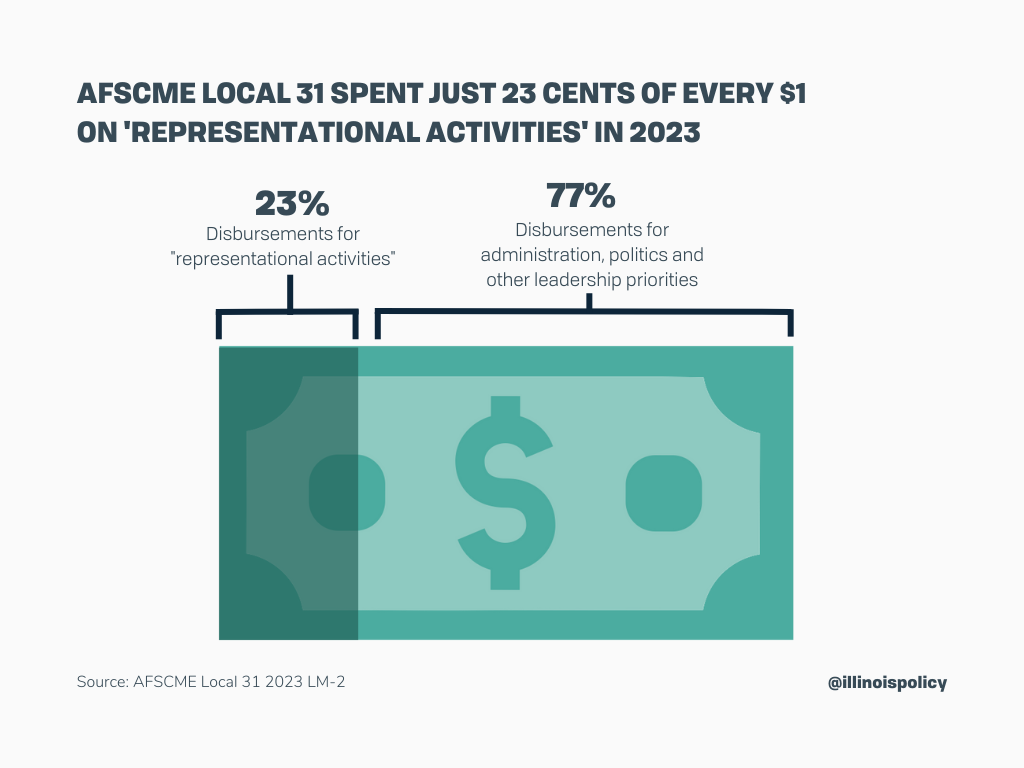Nearly 40% of Illinois government workers reject AFSCME membership
The union’s federal reports show the union has suffered membership loss during the past two decades. It could be because the union’s spending priorities are completely misplaced.
AFSCME Council 31 filed its 2023 federal report with the U.S. Department of Labor this spring, and its own numbers – from membership to spending practices – don’t look good.
The union claims to represent more than 90,000 state and local government employees in Illinois. Yet just 55,771 of those workers are members of the union, according to the union’s annual report, called an LM-2.
That means nearly 40% have rejected membership in the union supposedly representing their interests.
Since its peak in 2004, AFSCME Council 31 has seen a 21% drop in membership. It could be because just 23 cents of every dollar the union spends is on representing workers – what should be its core priority. Or it could be the millions of dollars AFSCME Council 31 spends on politics, or the exorbitant six-figure salaries it pays its bosses.
Whatever the reason, state and local government employees don’t have to be union members to retain their jobs. They can opt out of union membership and keep their hard-earned money in their own pockets and away from the union’s misplaced priorities.
AFSCME Council 31 has seen a 21% drop in membership since its peak in 2004
ASFCME Council 31 membership peaked in 2004, with 70,729 members. It has trended downwards since then.
With membership at just 55,771 in 2023, that represents a 21% drop.
But AFSCME’s membership situation might be worse than it appears in its LM-2. The union itself claims to represent more than 90,000 state and local government employees in Illinois. That means at least 34,229 workers AFSCME Council 31 claims to represent – or 38% – have chosen not to be members.
How can a union represent more workers than are members? State or local government workers don’t have to be members of the union representing their workplace if they don’t want to be members. Workers can choose not to be members when they are hired, or they can opt out of membership later.
Judging by AFSCME’s numbers, it appears thousands of workers aren’t happy with the way the union spends members’ dues and are deciding to keep their hard-earned money in their own pockets.
Just 23% of AFSCME Council 31’s spending in 2023 was on representing workers
Each year, ASFCME Council 31’s LM-2 shows how it received or spent money in the preceding fiscal year, according to its own accounting.
The union’s most recent report shows just 23% of its spending in 2023 was on “representational activities,” which the Department of Labor defines as including the negotiation of a collective bargaining agreement and the administration and enforcement of the resulting contract.

AFSCME Council 31’s total reported spending in 2023 was $42.46 million. Yet just $9.82 million was spent on representing workers – what should be the core purpose of the union. The rest was spent on politics, administration and other leadership priorities.
To put this in perspective, the Better Business Bureau’s Wise Giving Alliance states at least 65% of a nonprofit’s total expenses should be on program activities.
While the Wise Giving Alliance evaluates spending by charities, it stands to reason AFSCME Council 31’s spending of less than 23% on representation – the purpose of a union – should be a cause for concern among members.
The union spent nearly $1.3 million on politics in 2023
AFSCME Council 31 reported spending $1.27 million on “political activities and lobbying.” Of that amount, only $378,740 went to “named payees,” such as to its own political account.
The rest – more than 70% of the union’s political spending – was for unspecified purposes. Members have no way of knowing on what political candidates or causes that money was spent.
More than 70 officers and employees of the union earn six-figure salaries
Those who work for AFSCME Council 31 are well compensated. The top eight officers and staffers made over $150,000 in 2023, with 72 of the union’s own employees topping $100,000.
AFSCME Council 31 members can opt out of the union and stop paying dues
State and local government workers may not agree with the union’s spending practices, or they may feel the union doesn’t represent them well.
As John Moss, a former president of an AFSCME local put it, “[AFSCME Council 31] never had any backing for us at all. They never would stand up for us, they never did anything for us. We weren’t being represented. They wanted our dues, [and] to increase our dues … The only thing they want to benefit is themselves, their own checkbooks.”
Whatever the reason, government workers don’t have to be union members to keep their jobs.
By opting out of union membership, workers can stop paying dues to the union yet retain all benefits that are provided in the collective bargaining agreement with their government employer. Learn more at LeaveAFSCME.com.

